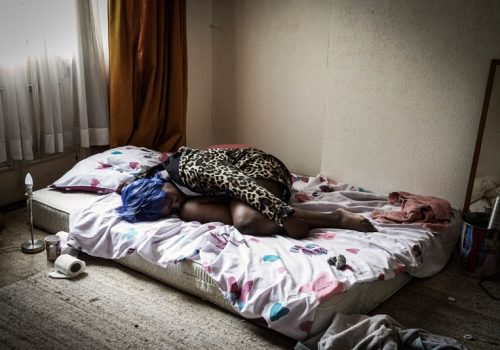Slavery was abolished in the United Kingdom in 1807 but more than 200 years on it still exists and affects some of the most vulnerable men, women and children. Commissioned by the UK’s National Crime Agency, Invisible People is a project by British photographer Rory Carnegie that seeks to raise awareness on modern slavery.
What I was trying to do with the series Invisible People was to create images that would show firstly how it felt to be a victim of modern slavery and secondly to illustrate the coping strategies, however small and pitiful, that the victims used in dealing with their appalling and disgusting situations.
I had worked quite extensively with young refugees and my postgraduate studies involved emergency practice, so I had a certain experience with vulnerable people and knew the importance of dignity in a human’s life. However wretched a person’s existence, there is always an attempt to preserve that self-respect. This is most poignantly shown in George Orwell’s ‘A Hanging’. In this essay on the walk to the gallows, his execution and imminent end of life fully realised, the condemned man sidesteps a puddle in his path. He still had his self-respect.
The victims of modern slavery are living and working in abject conditions but will, if they can, hold on to some degree of dignity. For example, in the photograph of the men that are living in the container, it shows them in cramped conditions with no running water and barely sufficient room to lie down, but they have tried in some way to domesticate. There are hooks and lines on which to hang clothes and there is a mirror with which they can both manage and monitor their appearance. These may appear to the everyday person small and insignificant issues, but they are in fact crucial to their continued existence.
One of the most prevalent coping strategies for victims of modern slavery is wishing or imagining themselves as either elsewhere or as a different person. The sex worker that lies on the bed wears a blue wig so that she might create a different person that is suffering such depredation. It is somebody else, not her that is having this horrible time. In another image, the sex worker that lies on the bed, seemingly spent and inert like a rag doll, has a blurred character moving away from her. That spectral blur is her real self, moving away, that can preserve her life with a degree of dignity.
When you are putting together a series of images, you want the images to work as a unit but also be sufficiently different to maintain the viewers interest. With me, there is also a huge treasure trove of photographs, films and paintings that I might call upon, stored in a memory bank, that will guide me when I am making some work. When I was photographing the young man that was working in slave conditions at the docks and on the fishing boats, I was thinking about a photograph taken almost 40 years earlier by Chris Killip in his series In Flagrante. The series documents the de-industrialisation of the north east of England and the photograph in question shows a young man, seen in profile, sitting on a wall, his knees to his chest and his face set in tight grimace showing his pain and that he just wanted to be elsewhere. There are many reasons why particular images resonate and stay, but it appeared to me, as I was crouched with my camera alongside a young bewildered man in his tattered plimsolls and torn and ill fitting oilskins, that I had been storing Killip’s image to help me show the desperate circumstances of the young man who was slumped in front of me and who wanted to be somewhere else.
Being ‘somewhere else’, however, can have dangerous consequences. The young man working in flip-flops amongst the ice will suffer long-term health conditions. In another image, the young man working in the abattoir who is ‘somewhere else’ is certainly not physically or mentally equipped to handle the meat cutting tools. His distraction and total exhaustion are very likely to cause a serious injury to himself.
The work with the young man in the abattoir also raises the issue and complication of visually defining Modern Slavery. Some viewers might respond saying he just looks like a hardly done by worker. We might see a picture of a young man or woman picking fruit or working in the fields and they will appear to the viewer exactly that, and not necessarily a victim of modern slavery. That image in itself does not explain the disgusting living conditions, the absence of pay and the other iniquitous and evil aspects of modern slavery. These victims might not be living in chains, but they are living amongst us.
Rory Carnegie
Rory Carnegie is a photographer, philosopher and blogger. He has worked for many leading publications on reportage and portraiture. He lives and works in Oxford, UK.
Rory Carnegie, Invisible People
Touring in England :
Bristol, Centre Promenade, Broad Quay, 13/14 January 2018
Manchester, Market Street, 20/21 January 2018
Belfast, Writer’s Square, 27/28 January 2018
Coventry, Lady Godiva statue, 3/4 February 2018
Plymouth, Piazza, 10/11 February 2018
Lincoln, Cornhill, 17/18 February 2018
Cardiff, Churchill Way, 24/25 February 2018
Glasgow, George Square, 3/4 March 2018
London, Westminster Abbey, 10/11 March 2018
http://www.nationalcrimeagency.gov.uk/news/1267-nca-s-invisible-people-exhibition-launches
















